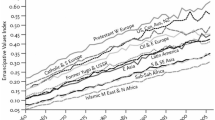Abstract
The semiotic investigation of the divine or transcendent authoriality of religious law involves, in the context of discussions concerning the propriety or impropriety of the influence of religion in “secular” political and legal systems, preliminary boundary work to discern the meanings of “religion”, “secular”, and “belief.” Jeremy Waldron’s account of the propriety of religion in “secular” politics, mirroring but reversing John Rawls’ account of religion’s impropriety in that context, can be contrasted with neo-Calvinist (and other) conceptions of pluralism and the inevitability of fundamental “beliefs” in all political and legal thought. In the latter perspectives, religious believers are neither unique in their appeal to transcendent values, nor relegated to advancing theocracy (because pluralism is conceived as a religious value rather than religion’s opposite). A workable alternative to the conventional discourse of religious influence in politics and law is therefore evident.
Similar content being viewed by others
Notes
“Rival claims of revelation are mutually unintelligible, like the mysteries of competing theologies; they mean nothing except to their adherents” [25; 15].
While the Oklahoma law specifically targeted Shari‘a law, other states “will have a better chance of withstanding judicial scrutiny if they remain focused on excluding the use of international law in state courts and not on Shariah itself” [10].
Tongue in cheek, a critical reviewer of the aforementioned four books on the Religious Right, who found the books to be alternatively exaggerated, over-simplified, paranoiac, and apocalyptic, noted that “Christian Reconstructionists … are genuine theocrats, of a sort, … who … rank somewhere between the Free Mumia movement and the Spartacist Youth League on the totem pole of political influence in America” [14; 24].
Waldron distinguishes his argument from those, like George Rupp, who contrast market individualism with communal altruism, because those in material comfort do have communities: “It is the limited altruism of community that is hardest to overcome for the sake of the outcast and the marginalized” [25; 10].
For Kuyper, the “goal of Christian social and cultural action is not to confessionalize society” by establishing a state church or an official religion; he wanted “a strong confessional church [but not] a confessional state … [The] secularization of state and society is one of the most basic ideas of Calvinism” [17; 165, 197].
References
An-Na‘im, Abduallah Ahmed. 2008. Islam and the secular state: The future of Shari‘a. Cambridge, MA: Harvard University Press.
Abdehady, Hdeel. 2009. Islamic law in secular courts (Again): Teachable moments from the journey. Available at http://papers.ssrn.com/sol3/papers.cfm?abstract_id=1835765. Originally published in International Law News 38/4:18.
Benson, Ian T. 2011. Unexamined faiths and the public place of religion: Emerging insights from the law. Acta Theologica 14: 1–19.
Berman, Harold J. 1983. Law and revolution: The formation of the western legal tradition. Cambridge, MA: Harvard University Press.
Blank, Yishai. 2011. The reenchantment of law. Cornell Law Review 96: 633–670.
Bouissac, Paul (ed.). 1998. Encyclopedia of semiotics. Oxford: Oxford Press.
Broekman, Jan M. 2001. Reiterating the literal. International Journal for the Semiotics of Law 14: 121–128.
Caudill, David S. 2007. Christian legal theory: The example of Dooyeweerd's critique of Romanist individualism and Germanic communitarianism in property law. The Georgetown Journal of Law and Public Policy 5: 531–560.
Caudill, David S. 2009. On realism’s own ‘Hangover’ of natural law philosophy: Llewellyn avec Dooyeweerd. In On philosophy in American law, ed. F.J. Mootz, 19–26. Cambridge: Cambridge University Press.
Chanen, Jill Schachner. 2011. The law of the land. ABA Journal, May 2011: 14.
Colapietro, Vincent M. 1993. Glossary of semiotics. New York, NY: Paragon House.
Dane, Perry. 2011. Book review: Islam and the secular state. Ancient traditions, new conversations, Mar. 8, 2011. Available at http://blogs.yu.edu/cjl/2011/03/08/islam-and-the-secular-state.
Dooyeweerd, Herman. 1996. Christian philosophy and the meaning of history, trans. J. Vriend. Lewiston, NY: The Edwin Mellen Press.
Douthat, Ross. 2006. Theocracy, theocracy, theocracy: A review of four books from the religious right’s perspective. First Things, Aug/Sept 2006: 23–27.
Hommes, Hendrik J. Van Eikema. 1979. Major trends in the history of legal philosophy, trans. P. Brouwer and J. Kraay. Amsterdam: North-Holland Publishing Co.
Jackson, Bernard. 2001. Editor’s introduction (to special issue on the semiotics of religious law). International Journal for the Semiotics of Law 14: 107–110.
Kuyper, Abraham. Common grace. In Abraham Kuyper: A centennial reader, ed. James D. Bratt, 165–203. Grand Rapids, MI: Wm. B. Eerdmans Publishing Company.
Leone, Massimo. 2009. The semiotic therapy of religious law. International Journal for the Semiotics of Law 22: 293–306.
Llewellyn, K.N. 1934. On philosophy in American law. University of Pennsylvania Law Review 82: 205–212.
Lombardi, Clark B. 2010. Can Islamizing a legal system ever help promote liberal democracy?: A view from Pakistan. University of St. Thomas Law Journal 7: 649–691.
McClain, Linda C. 2011. Religious and political virtues and values in congruence or conflict?: On Smith, Bob Jones University, and Christian Legal Society. Cardozo Law Review 32: 1959–2007.
Nöth, Winfried. 1990. Handbook of semiotics. Bloomington, IN: Indiana University Press.
Oman, Nathan B. 2011. “I will give unto you my law”: Section 42 as a legal text and the paradoxes of divine law. Available at http://ssrn.com/abstract=1811086; forthcoming in Embracing the law: Essays on doctrine and covenants section, ed. Jeremiah John. Salem, OR: Salt Press.
Sebeok, Thomas A. 1991. Semiotics in the United States. Bloomington, IN: Indiana University Press.
Waldron, Jeremy. 2010. Secularism and the limits of community. Available at http://ssrn.com/abstract=1722780.
Walter, Nicholas. 2011. The status of religious arbitration in the United States and Canada. Available at http://ssrn.com/abstract=1801103, forthcoming in Santa Clara Law Review.
Witte, John, and Joel A. Nichols. 2010. Faith-based family laws in Western Democracy? Fides et Libertas: The Journal of the International Religious Liberty Association 2010: 122–135.
Wolterstorff, Nicholas. 1976. Reason within the bounds of religion. Grand Rapids, MI: Wm. B. Eerdmans Publishing Co.
Author information
Authors and Affiliations
Corresponding author
Rights and permissions
About this article
Cite this article
Caudill, D.S. Boundary Work: Transcendence and Authoriality in Religious and Secular Law. Int J Semiot Law 26, 149–161 (2013). https://doi.org/10.1007/s11196-012-9263-z
Published:
Issue Date:
DOI: https://doi.org/10.1007/s11196-012-9263-z




